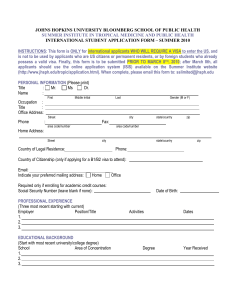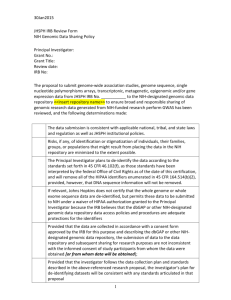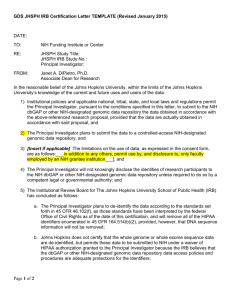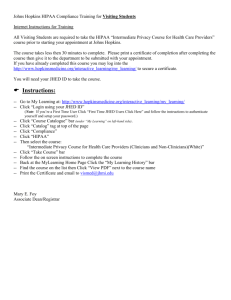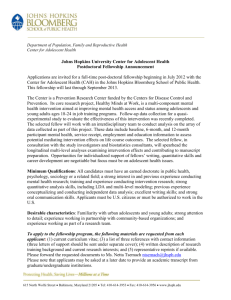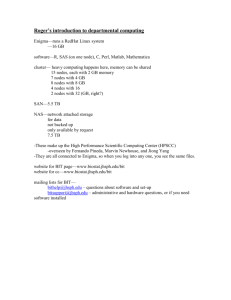Protected Health Information and the JHSPH
advertisement
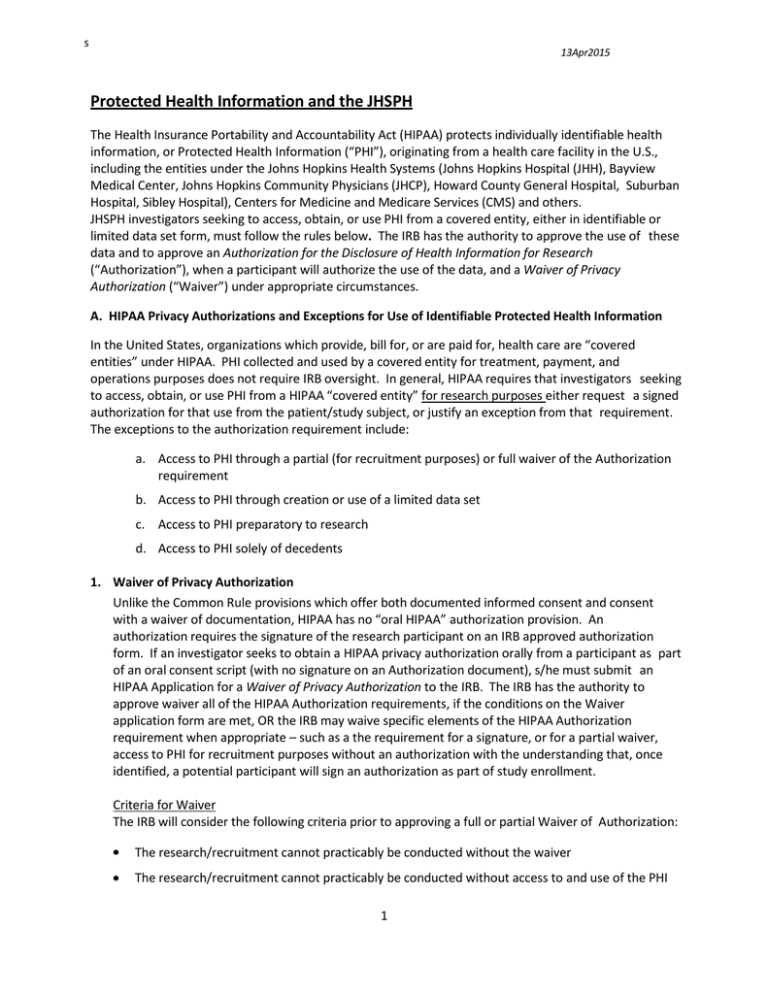
s 13Apr2015 Protected Health Information and the JHSPH The Health Insurance Portability and Accountability Act (HIPAA) protects individually identifiable health information, or Protected Health Information (“PHI”), originating from a health care facility in the U.S., including the entities under the Johns Hopkins Health Systems (Johns Hopkins Hospital (JHH), Bayview Medical Center, Johns Hopkins Community Physicians (JHCP), Howard County General Hospital, Suburban Hospital, Sibley Hospital), Centers for Medicine and Medicare Services (CMS) and others. JHSPH investigators seeking to access, obtain, or use PHI from a covered entity, either in identifiable or limited data set form, must follow the rules below. The IRB has the authority to approve the use of these data and to approve an Authorization for the Disclosure of Health Information for Research (“Authorization”), when a participant will authorize the use of the data, and a Waiver of Privacy Authorization (“Waiver”) under appropriate circumstances. A. HIPAA Privacy Authorizations and Exceptions for Use of Identifiable Protected Health Information In the United States, organizations which provide, bill for, or are paid for, health care are “covered entities” under HIPAA. PHI collected and used by a covered entity for treatment, payment, and operations purposes does not require IRB oversight. In general, HIPAA requires that investigators seeking to access, obtain, or use PHI from a HIPAA “covered entity” for research purposes either request a signed authorization for that use from the patient/study subject, or justify an exception from that requirement. The exceptions to the authorization requirement include: a. Access to PHI through a partial (for recruitment purposes) or full waiver of the Authorization requirement b. Access to PHI through creation or use of a limited data set c. Access to PHI preparatory to research d. Access to PHI solely of decedents 1. Waiver of Privacy Authorization Unlike the Common Rule provisions which offer both documented informed consent and consent with a waiver of documentation, HIPAA has no “oral HIPAA” authorization provision. An authorization requires the signature of the research participant on an IRB approved authorization form. If an investigator seeks to obtain a HIPAA privacy authorization orally from a participant as part of an oral consent script (with no signature on an Authorization document), s/he must submit an HIPAA Application for a Waiver of Privacy Authorization to the IRB. The IRB has the authority to approve waiver all of the HIPAA Authorization requirements, if the conditions on the Waiver application form are met, OR the IRB may waive specific elements of the HIPAA Authorization requirement when appropriate – such as a the requirement for a signature, or for a partial waiver, access to PHI for recruitment purposes without an authorization with the understanding that, once identified, a potential participant will sign an authorization as part of study enrollment. Criteria for Waiver The IRB will consider the following criteria prior to approving a full or partial Waiver of Authorization: The research/recruitment cannot practicably be conducted without the waiver The research/recruitment cannot practicably be conducted without access to and use of the PHI 1 s 13Apr2015 The research application must have an adequate plan to protect the PHI from unapproved use/disclosure The research application must include a plan to destroy the identifiers at the earliest possible moment. The Application for Waiver requires that the PI attest that the PHI will not be reused or disclosed to any other person or entity, except as required by law, for authorized oversight of the research study, or for other research for which the use or disclosure of protected health information would be permitted under the terms of Privacy Rule. Examples: Full Waiver of Privacy Authorization: A researcher wishes to create a de-identified analytic data set of patients who have had pancreatic cancer from a medical records database. The researcher will see the PHI of the selected patients, but will not record the PHI or use it for research purposes. The IRB may conclude that it is impracticable for the researcher to contact and obtain authorization from all the participants, and the research cannot proceed without access and use of the PHI. The PHI will not be recorded, so it will be protected from unapproved use or disclosure. Note: The rules for data abstraction through a Johns Hopkins “Covered Entity” are a little different; a Business Associate Agreement is required when the JHSPH investigator is performing the records abstraction. See 2A below. Partial Waiver of Privacy Authorization for Recruitment: A researcher wishes to identify individuals who have undergone retinal reattachment surgery to conduct a quality of life survey. The researcher proposes to identify the potential participants using medical records, then will contact them through the patient’s clinician. The identifiable information will be used for contact purposes only, and the researcher will retain PHI for only those individuals who agree to participate. The PHI from patients who are not contacted successfully or who decline to participate will be destroyed. 2. Use of De-Identified and Limited Data Sets Definitions De-Identified Data Set A de-identified data set is one which has all the HIPAA identifiers removed (see list of identifiers here: http://www.jhsph.edu/hipaa/FAQ#identifiers.) Use of this data set requires no authorization, no waiver, and IRB oversight only if collected in association with a previously reviewed study and the proposed use is outside the scope of that original approval. Limited Data Set A limited collection of PHI, which if obtained from health care providers (“covered entities”), does not require an IRB approved Authorization or a Waiver. The Limited Data Set may include only the following identifiers: dates such as admission, discharge, service, DOB, DOD; city, state, five digit or more zip code; and ages in years, months or days or hours. 2 s 13Apr2015 However, a limited data set may be obtained only with use of a Data Use Agreement (DUA) between JHSPH and the covered entity. Using Data Sets from a Covered Entity JHSPH is not a “covered entity.” If a JHSPH faculty member submits a research application to the IRB proposing to use a de-identified data set or a limited data set, the compliance requirements will depend upon: 1) whether the covered entity is a Hopkins entity, and 2) who creates the de-identified data set or limited data set. JHSPH investigators who use PHI in research should take HIPAA training either through CITI or, if the data will come from Johns Hopkins Medicine, through the SOM IRB. i. Hopkins Covered Entity is the Source of the De-Identified, or Limited Data Set To execute the documents referenced below (Business Associate Agreement and Data Use Agreement) through Don Bradfield at the JH HIPAA Office, JHSPH investigators must complete a form called “BAA DUA Investigator Request Form - Hopkins Data”. Contact the JHSPH IRB Office if you need assistance. 1. JHSPH Investigator Creates the De-Identified Data Set or Limited Data Set: Since the JHSPH investigator is performing a service by abstracting the data from the medical records, the investigator is a “business associate” of the covered entity for that purpose. A Business Associate Agreement (“BAA”) must be executed through Don Bradfield at the Johns Hopkins HIPAA Office. The investigator must submit an IRB application. In this instance, the IRB will not need to approve a Waiver (because the BAA is in place), and the study will likely be Exempt from IRB review under Category 4. a. De-Identified Data Set: If the JHSPH investigator creates a data set that includes no HIPAA identifiers, the PI would need to complete the Business Associate Agreement, but not a Data Use Agreement (“DUA”, required for a Limited Data Set, below). The investigator should complete an IRB application, which will likely be determined to be Exempt from IRB review under Category 4. b. Limited Data Set: If the JHSPH investigator creates a limited data set, the PI would need to complete the Business Associate Agreement. Once the limited data set was created, then a DUA would need to be completed. Again, Don Bradfield at the Johns Hopkins HIPAA Office should be contacted. 2. The Hopkins Covered Entity Creates the Limited Data Set or De-Identified Data Set: If the covered entity abstracts the records, or uses another third party business associate to do so, and then discloses (or provides) the de-identified data set or limited data set to the JHSPH faculty member, no Authorization or Waiver is required. The submission to the IRB may receive a Not Human Subjects Research or Exempt determination, depending upon the project description. a. De-Identified Data Set: The JHSPH investigator who will “obtain” a de-identified data set from the Hopkins covered entity may not need to submit an IRB application, unless the data set includes de-identified information originally collected by the JHSPH investigator. 3 s 13Apr2015 b. Limited Data Set: The PI must sign a Data Use Agreement using the Hopkins DUA template (see: http://www.hopkinsmedicine.org/institutional_review_board/hipaa_research/forms.ht ml) ii. A Non-Hopkins Covered Entity is the Source of the Limited Data Set 1. JHSPH Investigator Creates the Limited Data Set: The JHSPH investigator must check with the covered entity for its HIPAA policies and procedures. The investigator must submit an application to the IRB, and will ask the IRB to approve a Waiver or an Authorization. If the covered entity offers its own Data Use Agreement template, the JHSPH investigator should not sign it until approved by Don Bradfield. The Hopkins DUA may be used without review by Don Bradfield, unless there is a substantive change to it. a. De-Identified Data Set: The JHSPH investigator should submit an IRB application and obtain a Waiver or Authorization, but will not need to sign a Data Use Agreement. 2. The Non-Hopkins Covered Entity Creates the Limited Data Set: If the covered entity is “disclosing” a limited data set to a JHSPH investigator for use in research, the JHSPH investigator must submit an application to the IRB. The covered entity may or may not require the investigator to sign a data use agreement, but we recommend that the JHSPH investigator offer the Hopkins template as an option. If the covered entity does not want to execute a DUA, the PI should ask the IRB for a Waiver. a. De-Identified Data Set: The JHSPH investigator may not need to submit an IRB application, unless the data set includes de-identified information originally collected by the JHSPH investigator. The investigator does not need to sign a DUA. Examples: A JHSPH PI will go to JHCP to interview patients about the quality of care for mental health. The information collected will have the patients’ names, age, gender, and diagnostic information. The JHSPH PI will need to collaborate with the JHCP clinic to obtain access to names of potential participants. If the JHCP provider/researcher (collaborator) contacts the potential participants directly to inform them about the study, there are no HIPAA recruitment implications. The JHCP provider already has the access to the PHI and is only using it for referral purposes. If the JHSPH PI will be given access to the medical records to abstract him/herself, the JHSPH PI is acting as a “business associate” of the JHCP and will need to complete a business associate agreement. If the JHSPH PI will contact the participants to inform them about the study, the IRB would have to approve a HIPAA Waiver of Authorization to permit the PI to use the PHI information for recruitment purposes. The JHSPH PI should enter the disclosure information in the tracking database, and check the HIPAA Compliance database to make sure none of the patients on the list have expressed a desire not to be contacted for future research. The JHSPH PI should add to the Compliance database information about any patients whose records include an entry expressing the desire not to be contacted. 4 s 13Apr2015 The JHSPH PI will obtain signed informed consent from the study participant. The consent process should include documentation of the HIPAA Authorization so that the participant can authorize the use of his/her PHI for research purposes. The IRB will approve the HIPAA Authorization language either as part of the consent form, or as an independent document. Oral Consent/Authorization: If the JHSPH investigator will be obtaining informed consent from a person identified through a covered entity, and the consent will be presented orally with no identifiers recorded on the interview form, HIPAA is still implicated. The JHSPH researcher will know the identity of the participant while sitting with them face to face. The JHSPH PI should request a Waiver of Privacy Authorization from the IRB, specifically requesting that the requirement for a signature be waived. HIPAA Authorization language should be included in the oral consent script. C.The Compliance Database: Tracking and Recruitment If the IRB approves a Waiver of Privacy Authorization, and the JHSPH investigator obtains PHI disclosed from a JH “covered entity” (JHH, Bayview, Howard County General, JHCP, etc.) involving less than 50 patients/health plan members, the JHSPH investigator must “track” this disclosure for each individual by creating a new record in the SPH JH HIPAA Compliance System. The Compliance System may be accessed at https://apps3.jhsph.edu/SPH-JH-HIPAA- Compliance/index.cfm. List the first and last names, and email addresses, of participants whose disclosed information will be tracked. For studies involving 50 or more JH covered entity patients/health plan members, the investigator must complete a “BAA DUA Investigator Request Form - Hopkins Data” so that the IRB Office may retain a record. If a JHSPH investigator obtains PHI from a covered entity for research involving only decedents, that disclosure must be tracked through the Compliance Database system. If a JHSPH researcher obtains a Waiver of Privacy Authorization for recruitment purposes, with the intent to look into JH patient records to identify possible participants, and sees in the record an entry that an individual does not wish to be contacted for research purposes, the JHSPH investigator must log that information into the Compliance System database. JHSPH investigators who wish to use JH patient records for recruitment purposes must first check the compliance database to identify individuals who have expressed that preference not to be contacted, and honor the person’s wishes. D. International Studies and HIPAA If your study is collecting PHI from a health care provider overseas, and the data are sent to JHSPH, the study is not covered by HIPAA. However, if the coded, but identifiable PHI from overseas was sent to a JH covered entity, like the School of Medicine or Nursing, the PHI may become subject to HIPAA protections. E.Definitions: Authorization: Document that gives covered entities permission to use protected health information for specified purposes, which are generally other than treatment, payment, or health care operations, or to disclose protected health information to a third party specified by the individual. An authorization must specify the following: a description of the protected health information to be used and disclosed, the person authorized to make the use or disclosure, the person to whom the covered entity may make the disclosure, an expiration date, and, in some cases, the purpose for which the information may be used or 5 s 13Apr2015 disclosed and the signature of the patient/participant. Disclosure: The release, transfer, provision of, access to, or divulging in any other manner of PHI to persons or entities outside of the Johns Hopkins Covered Entities and Related OHCA Participants. HIPAA: the Health Insurance Portability and Accountability Act of 1996. Protected Health Information (PHI): Individually identifiable health information, as defined under the Privacy Regulations promulgated under HIPAA. PHI may include any of the following: Name Geographic information smaller than state Elements of dates (birth date, admission date, date of death, ages greater than or equal to 90 years of age Telephone numbers Fax numbers Electronic mail addresses Social security numbers Medical record numbers Account numbers Certificate or license number Vehicle identifiers and serial numbers including license plate Device identifiers and serial numbers URLs IP address numbers Biometric identifiers Full face photographic images and comparable images Health Plan beneficiary numbers Any other unique identifying number, characteristic or code De-identified Data Set: If the HIPAA identifiers or PHI are removed from the research data before the JHSPH researcher accesses it, the data set is considered to be “de-identified”. Identifiers include: 1. Names; 2. All geographical subdivisions smaller than a State, including street address, city, county, precinct, zip code, and their equivalent geocodes, except for the initial three digits of a zip code, if according to the current publicly available data from the Bureau of the Census: (1) The geographic unit formed by combining all zip codes with the same three initial digits contains more than 20,000 people; and (2) The initial three digits of a zip code for all such geographic units containing 20,000 or fewer people is changed to 000. 3. All elements of dates (except year) for dates directly related to an individual, including birth date, admission date, discharge date, date of death; and all ages over 89 and all elements of dates (including year) indicative of such age, except that such ages and elements may be aggregated into a single category of age 90 or older; 4. Phone numbers; 5. Fax numbers; 6. Electronic mail addresses; 7. Social Security numbers; 8. Medical record numbers; 9. Health plan beneficiary numbers; 10. Account numbers; 11. Certificate/license numbers; 12. Vehicle identifiers and serial numbers, including license plate numbers; 6 s 13Apr2015 13. Device identifiers and serial numbers; 14. Web Universal Resource Locators (URLs); 15. Internet Protocol (IP) address numbers; 16. Biometric identifiers, including finger and voice prints; 17. Full face photographic images and any comparable images; and 18. Any other unique identifying number, characteristic, or code (note this does not mean the unique code assigned by the investigator to code the data) Use of this data set requires no authorization, no waiver, and IRB oversight only if collected in association with a previously reviewed study and the proposed use is outside the scope of that original approval. Limited Data Set: A limited collection of PHI, which if obtained from health care providers (“covered entities”), does not require an IRB approved Authorization or a Waiver. The Limited Data Set may include only the following identifiers: dates such as admission, discharge, service, DOB, DOD; city, state, five digit or more zip code; and ages in years, months or days or hours. However, a limited data set may be obtained only with use of a Data Use Agreement (DUA) between JHSPH and the covered entity. Use: The sharing, employment, application, utilization, examination or analysis of PHI within the Johns Hopkins Covered Entities and Related OHCA Participants. HIPAA "Covered Entities" The HIPAA regulations apply to any entity that is a: Health Plan (self insured/insured, HMOs, health insurance companies, employer health plans and similar arrangements) Health Care Provider (who transmit electronic transactions covered by the HIPAA regulations) Health Care Clearinghouse Medicare Part D Pharmaceutical Providers An entity that is one or more of these types of entities is referred to as a "covered entity." Johns Hopkins "Covered Entities" include: PROVIDERS The Johns Hopkins University School of Medicine The Johns Hopkins University School of Nursing The Johns Hopkins Hospital (not including Occupational Health) Johns Hopkins Bayview Medical Center, Inc. (not including Occupational Health) Hopkins ElderPlus (a provider, a health plan and a Part D Provider) Howard County General Hospital, Inc. (not including Employee Health) Sibley Memorial Hospital 7 s 13Apr2015 Suburban Hospital All Children's Hospital The Johns Hopkins Medical Services Corporation Johns Hopkins Community Physicians, Inc. Priority Partners Managed Care Organization, Inc. (a provider and a health plan) Johns Hopkins Pharmaquip, Inc. Johns Hopkins Home Health Services, Inc. Johns Hopkins Pediatrics at Home, Inc. Ophthalmology Associates, LLC Creative Alternatives The Central Maryland Heart Center, Inc. The Center for Ambulatory Services, Inc. (TCAS) HCP Venture One Corporation Howard County MRI Limited Partnership Cedar Emergency Services Company, Inc. Ambulatory Blood Gas Services. Inc. JH Ventures, LLC / Howard County Neonatal Services Series JH Ventures, LLC / Frederick County Neonatal Services Series JH Ventures, LLC /HCGH OB/GYN Associates Services (d/b/a Signature OB/GYN) JH Ventures, LLC / JHHC Participating Physician Series JH Ventures, LLC / Johns Hopkins Emergency Medical Services Series JH Ventures, LLC / Wyman Park ASC Series Affected researchers in the following Johns Hopkins Schools: The Whiting School of Engineering The Krieger School of Arts and Sciences The Applied Physics Laboratory ORGANIZED HEALTH CARE ARRANGEMENT The Kennedy Krieger Institute Non-Johns Hopkins Employed Medical Staffs Credentialed at: The Johns Hopkins Hospital Johns Hopkins Bayview Medical Center Howard County General Hospital HEALTH PLANS The Johns Hopkins University Welfare Plan* Benefit Elections Program Plan* SOM & SPH Student Health Program SOM Dental Insurance Program Student Health Insurance Plan APL Medical and Dental Insurance Plans APL Health Care Spending Account APL Employee Assistance Program The Johns Hopkins Health System Bayview Medical Center Employee Benefits Plan Represented Employee Benefits Plan House Staff Employee Benefits Plan 8 s 13Apr2015 Employee Assistance Plan Long Term Care Insurance Plan Broadway Services EHP Medical P l a n Johns Hopkins Health System Corporation/Johns Hopkins Hospital Employee Benefits Plan for Non-Represented Employees* Johns Hopkins Hospital Employee Benefits Plan for Represented Employees* Hopkins ElderPlus (a provider, a health plan and a Part D Provider) Howard County General Hospital: EHP Medical Plan Blue Choice MDIPA CareFirst BC/BS Dental Plan Care First BC/BS Select Vision Plan Flexible Benefit Plan (Medical Reimbursement) Employee Assistance Plan LongTerm Care Insurance Program Priority Partners Managed Care Organization, Inc. (a provider and a health plan) Uniformed Services Family Health Plan at Johns Hopkins * "Wrap" or umbrella plans that may have a variety of component plans encompassed within them, including various insurer offerings, employee assistance plans (EAPs), medical flexible spending accounts (FSAs), etc. 9
